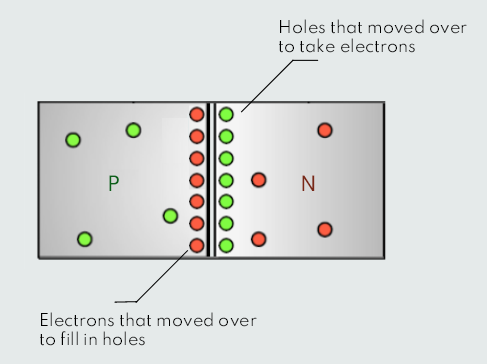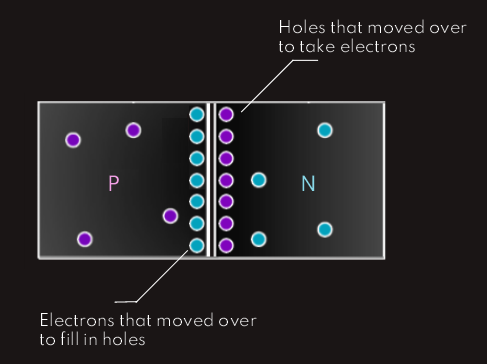
Diodes
A diode is a semiconductor device that essentially acts as a one-way switch for current. It allows current to flow easily in one direction, but severely restricts current from flowing in the opposite direction. Diode is one of the important components used in electronic circuits. A diode is so called because it has two terminals: the anode, the positive terminal, and the cathode, the negative terminal. In the case of a p-n junction diode the anode is the p-type and the cathode is the n-type.
P-type materials are intrinsic crystals of silicon or germanium subjected to controlled impurification with chemical elements from the third column of the periodic table (e.g., boron or aluminum). N-type materials are intrinsic crystals of silicon or germanium subjected to controlled impurification with chemical elements from the fifth column of the periodic table (e.g., phosphorus, arsenic, antimony, bismuth).




When we put a small piece of n-type semiconductor next to a small piece of p-type semiconductor, the extra electrons in the n-type conductor attempt to move over into available holes in the p-type conductor. At the same time, some of the holes in the p-type conductor end up moving over to the n-type to meet up with electrons. When this happens, we end up with an excess of electrons on the p-type side and extra electrons on the n-type side, creating an electrical imbalance. This electrical imbalance is known as the barrier potential and is shown above on the first figure. In silicon, this barrier potential is about 0.7 Volts.
Now, when we apply an external voltage to p-n junction, depending on which direction we apply the voltage, we get what we call the forward and reverse bias, shown above, also.
If we apply a positive voltage to the p-type material and a negative voltage to the n-type material, we are applying a forward bias to the semiconductor. First, the negative voltage at the n-type material is going to attempt to push electrons towards the junction in the middle. The positive voltage at the p-type material will push the holes towards the barrier as well. This reduces the barrier potential. If the barrier potential is reduced enough, the charge carriers can move through the barrier and out the other side, which means that current flows.
Applying a reverse voltage to our semiconductor material is known as reverse bias. In this condition, the electrons are pulled away from the barrier on the n-type side and the holes are pulled away from the barrier on the p-type side, which results in a larger barrier and creates a much greater resistance for charges to flow through. The result is that no current flows through the barrier.
Diodes are similar to one-way valve. In diodes, current flows only from anode to cathode. The diode is called “forward biased” when it conducts current. The diode is called “reverse biased” when it blocks current.
One of the important applications of diodes is rectification. Rectification is the process of making a DC voltage from an AC voltage. We have seen earlier schematics diagram of half and full wave rectifier...
Protection against polarity reversal
Polarity matters in sensitive electronic circuits. Some circuits can be easily destroyed by applying a reverse voltage.
Let's consider a sensitive consumer which + and – terminals of input voltage must be connected to A and B, respectively, so we can protect this device by adding a diode in series.
When the diode is forward biased it permits the current to pass through. Therefore, the device is energized. Now assume that reverse voltage is applied. The diode is reverse biased in this case and blocks the current flow. Therefore, the device is protected against reverse voltages.
Light Emitting Diode (LED)
A light-emitting diode (LED) is a special diode that emits light when an electric current flows through it. LEDs allow the current to flow in the forward direction and blocks the current in the reverse direction. The typical voltage drop across a forward biased LED is around 1.5 V – 2 V. LEDs are commonly used as an indicator (e.g. laptop LEDs), source of light (e.g. LED lamps) or pixels of a display (e.g. Dot-matrix display).
Seven segment is a device to display decimal numerals. Seven segments are composed of seven (or sometimes eight) LEDs. A typical seven segment shown below has a, b, c, d, e, f, and g LEDs used to display decimal numbers and the DP LED displays decimal point.
Seven segment displays are divided into two groups: common cathode displays and common anode displays, shown above on the right side.
Infrared Diodes
Remote controls have a special type of LED which is placed into the pointing end of the handset. The LED in remote controls doesn’t generate any visible light; but it generates infrared light which is invisible with the naked eye.
When a button is pressed, the circuit inside the handset forces the LED to generate infrared light pulses. The pulses form a pattern unique to the pressed button. Each button on a remote control corresponds to a specific binary code. When we press a button, it sends this code as an IR signal. The receiving device has a matching set of codes, and when it recognizes a code, it performs the corresponding action. The receiver in the device recognizes the pattern and causes the device to respond accordingly. The remote is called the transmitter, and the TV is called the receiver.
If we have more than one remote control in our home we may now be wondering why our TV remote doesn’t turn on our stereo or the neighbours TV. There are a couple of reasons; the first is “line of sight”, the second is that different companies use different codes for controlling their devices. So a remote control to turn a stereo volume up would use a different code to turn a TV volume up. There are also universal remote controls that can turn off any TV since they have all the codes built into one device.
Many modern TV’s have started using a technology called Bluetooth to send messages. They work the same way as the Infrared remotes but instead of sending light pulses, they send the codes to the device via radio waves.
Many electronics manufacturers now offer apps that allow us to control their devices from our smartphone. Additionally, smartphones often include technologies like Bluetooth and Wi-Fi, which can be used to control a wide range of smart home devices.
Or maybe we have a voice assistant and control our TV by our voice, also.






